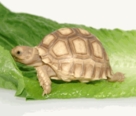Yellow Footed Tortoises (Adult) - Geochelone denticulata

The Chelonoidis Denticulata more popularly known as theYellowFootedTortoise is regarded as the largest South American Tortoise. It belongs to the species Testudinae, commonly known asForest Tortoise, The Brazilian Giant Tortoise, South American Yellow Footed Tortoise and the South American Tortoise.Its scientific name has been a topic of debate for long in the biodiversity community. Formerly it was named Geochelone Denticulata but the name was changed to Chelonoidis Denticulata, later. The Yellow Footed Tortoise is endemic to Brazil, Bolivia, Peru, Guyana and Colombia. Its carapace is huge and oval with roughly parallel sides. It is highly domed and slightly flat at the top around the vertebral scutes. The posterior and anterior margins of the scute are slightly serrated but the rest of the carapace is smooth and even. The color of the carapace can vary among the shades of brown, slightly orange and black around the edges of its scutes. The areola in every scute is orange, yellow or light brown. The plastron is usually brownish-yellow or yellowish-brown. The plastron is yellowish-brown or brownish –yellow and is almost black around the rims. The plastron is thick and is stunted towards the anterior end. The head is comparatively small and is covered withcream and yellow colored patches. Similar patches are visible behind the eyes. The jaws are slightly notched. Their forelimbs are covered with yellow or cream scales that give them the name ‘Yellow Footed’. The Yellow Footed Tortoise has a slightly convex that appears to be stretched along the length. Males have a concave plastron while females and juveniles have flat plastrons. The females of the species are shorter than the males but tend to grow heavier and have a short stubby tail. Males have a longer tail and grow up to 16 inches. Females usually only grow up to 14 inches. However the largest Yellow Footed Turtle measured 37 inches. Hatchlings are abandoned by their parents and have to take care of themselves on their own. They have a long lifespan and can live for over 60 years.
Yellow Footed Tortoise Habitat
The Yellow Footed tortoises are normally found in or around dry lands, savannah, grasslands, and rainforests adjacent to more open areas. In captivity, keepers are advised to accommodate them in a 60 gallon terrarium. As the tortoise grows the size of the water tank should be upgraded accordingly. The optimum air temperature is around 75-85 degrees Fahrenheit.Moist mulch, leaf litter, humus, soil and sand are recommendedas substrates. The tortoise is a digger and prefers soft substrate to dig up burrows and nest or hide. 24X7 availability of fresh clear, filtered water is essential. The water area should be deep enough for the tortoise to completely dip s and when it wants. An artificial basking area should be prepared under a regular heat lamp and a UVB light.
Yellow Footed Tortoise Diet
The Yellow Footed Tortoise is an omnivore. It feeds on mushrooms, fruits, grass, leafy vegetable and slow moving mollusks such as snails and worms. If you find them gobble small pebbles, don’t worry it helps them digest food.

Before Placing Your Order
Store InformationShipping Info
Payment Info
Return Policy
Arrive Alive Guarantee
Adoptation Policy
After Placing Your Order
Track Your OrderSecurity Safe Shopping
Compatibility Chart
Shoppers Review









